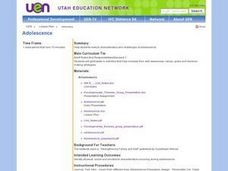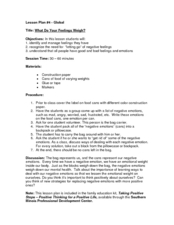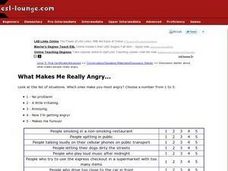Health Smart Virginia
Stressors, Coping Strategies, Mindfulness breathing
After discussing the benefits of positive coping strategies, class members practice the stress management and stress reduction technique of Mindfulness Breathing.
Thoughtful Learning
Using Perspective Shifting to Persuade Readers
One of the key competencies of social and emotional learning is social awareness and being able to see things from another's perspective. This ability to shift perspective is particularly important when crafting an argument to persuade...
Overcoming Obstacles
Playing by the Rules
The takeaway from the "Playing by the Rules" instructional activity is that it is each person's responsibility to learn the rules in a given situation and that they must accept the consequences if they choose not to follow the stated...
Thoughtful Learning
Setting and Reaching Goals
An activity boosts self-management through goal setting and reflection. Scholars choose one goal they wish to obtain by the end of the week. Participants brainstorm ways to make their goal a reality then reflect on whether or not their...
Health Smart Virginia
Mindfulness Breathing
The more you practice, the better you get. That's the big idea behind a lesson for middle schoolers about using mindfulness breathing techniques to reduce stress. Class members practice Star Breathing and Rainbow Breathing exercises and...
Health Smart Virginia
Mindfulness Yoga
Standing pose, tree pose, warrior pose, easy pose. Middle schoolers learn several basic yoga exercises and poses that can help them relax. They also keep a four-week stress log to track stressful situations and how they dealt with them.
Health Smart Virginia
What's Up with Mindfulness
Mindfulness is all about paying attention to the present. Introduce freshmen to a stress-reducing tool that helps them pay close attention to what is happening, choose their behavior, and respond. Learners use a timeline to track their...
TeenMentalHealth
Know Before You Go Teacher’s Guide
A 124-page guide provides instructors with what they need to know before launching a seven-lesson thematic unit designed for high school seniors on issues they will face after graduation. Topics covered include mental health and...
Nemours KidsHealth
Online Safety: Grades 6-8
Recognize risky behaviors and avoid them! That's the big idea behind two activities designed to teach middle schoolers to think critically about online safety. After reading background articles about protecting online identity,...
Health Smart Virginia
Wrinkled Heart
Contrary to the old saying, words, like sticks, can hurt. That's the central idea in a lesson about the importance of considering another person's perspective, stopping, thinking, and listening before responding in anger to a conflict....
Curated OER
Bully Prevention
Young scholars examine the topic of bully prevention. In this character education lesson, students establish what bullying is, role play bullying scenarios, and discuss how to manage bullying incidents.
Curated OER
Angry Feelings (Responsible Personal Conduct)
Students review proper classroom behavior and anger management techniques.
Council for the Curriculum, Examinations and Assessment
Safety and Managing Risk
Look before you leap! Learning how to analyze the risk involved before engaging in an activity is the focus of this lesson. Class members examine rules, both within their families and society at large, and consider why these boundaries...
Council for the Curriculum, Examinations and Assessment
Safety and Managing Risk
Teenagers love to take risks to test their personal boundaries, but many risks are too dangerous to try. The set of exercises in this packet teach your class about the ways they can stay safe and protect themselves while still having fun.
Curated OER
Anger (Part 1): Identifying Our Style
Students identify the two common sources of anger. For this psychology lesson, students discuss productive ways to express anger. They complete a reflection worksheet at the end of the lesson.
Curated OER
How Do You Feel?
Students examine how to express their emotions. In this emotional health lesson, students explore and share the emotions and feelings that have relating to the 9/11 terrorist attacks.
Curated OER
Relaxation Station
Second graders explore the Relaxation Station which teaches students how to C.O.P.E. with stress and anxiety. They discover helpful strategies to use in a classroom center.
Curated OER
Social Studies: Adolescent Characteristics
Students examine the various characteristics of adolescence. In a Powerpoint presentation they observe the physical, emotional, and social traits of adolescence. In groups, they investigate researchers associated with developmental...
Greater Good Science Center
Nurturing Gratitude From the Inside Out: 30 Activities for Grades K–8
Teach the importance of showing gratitude at any age with a teacher's guide comprised of thirty activities. Browse the extensive table of contents to find the array of exercises designed to meet the needs of your learners. Scholars take...
Curated OER
Wellness Day
Plan a wellness day! Invite speakers from community resources to come and present and participate in a wellness day. Reinforce how important it is to take care of the whole body and how the choices they make now can make a difference...
Curated OER
What Do Your Feelings Weigh?
Love this lesson! Learners fill cans with slips of paper to identify positive and negative feelings. They connect negative feelings to weight, and discuss how negativity can get you down. What a wonderfully visual way for learners to...
Curated OER
Angry Words: What Goes Around Comes Around
Students examine how angry words can effect the people and environment around them and identify ways to cope with angry feelings. They listen to the book Andrew's Angry Words by Dorothea Lachner, and participate in a simulation of how...
Curated OER
What Makes Me Really Angry
For this ESL emotion worksheet, students respond to 9 situations that bring about anger. Students rate their level of anger from one to five.
Curated OER
Emotions in Motion
Young scholars use dance as a form of communication. In this meanings of dance lesson, students create dances to communicate a variety of emotions.

























